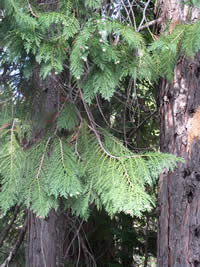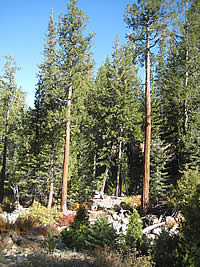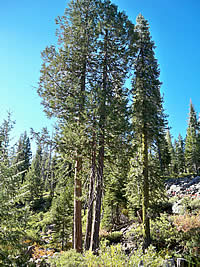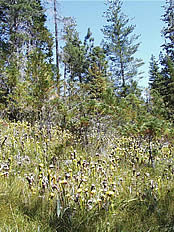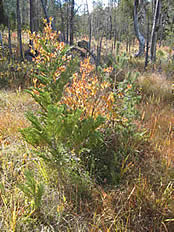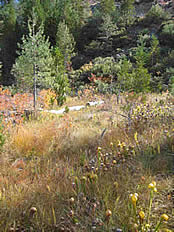USDA Forest Service Celebrating Wildflowers
|
|
|
Port-Orford-Cedar Plant Communities on Serpentine
Port-Orford-cedar (Chamaecyparis lawsoniana), named after the coastal town Port Orford, Oregon, near the Oregon/California border, occupies a narrow range in the western United States from southwest Oregon to northwest California, in the Coast and Klamath-Siskiyou Mountain Ranges. Although restricted to a small range that covers only 220 miles (350 km) from north to south, Port-Orford-cedar occupies many vegetation zones, soil types, and elevations. It commonly grows in mixed stands but occasionally forms pure stands. Throughout its range, Port-Orford-cedar occurs on ultramafic parent material, particularly where the water table is close to the surface (perched); scattered, perched water tables are characteristic of ultramafic parent material. Port-Orford-cedar occurs on many different soil types including dune sands, organic bog soils, and soils derived from gabbro, diorite, serpentine, peridotite, river alluvium, and other rock types. Port-Orford-cedar plant associations characterize the broad range of habitats in which Port-Orford-cedar is found. These plant communities display some of the richest plant species diversity of all forest types in the region. Most low elevation Port-Orford-cedar forests occur on soils derived from ultramafic parent materials. Port-Orford-cedar is more successful in communities where the parent material is at least partially derived from ultramafic rock and where competition is somewhat reduced. Port-Orford-cedar is found from sea level to 6,400 feet in elevation. Port-Orford-cedar is distributed over an area that generally has warm, dry summers and cool, wet winters - the Mediterranean climate of the California Floristic Province. Precipitation across the range varies between 35 to 140 inches annually. Most stands in California receive at least 59 inches (150 cm) of precipitation annually; at high elevations on the Siskiyou National Forest in southwest Oregon, Port-Orford-cedar stands receive 90 inches of annual precipitation. Inland disjunct stands in the eastern Klamath Ranges of California receive at least 49 inches (125 cm) of precipitation annually. On serpentine soils, Port-Orford-cedar associates most often with western white pine (Pinus monticola), incense-cedar (Calocedrus decurrens), white fir (Abies concolor) and Douglas-fir (Pseudotsuga menziesii), depending on elevation and temperature. On upland sites, the most common understory shrub is huckleberry oak (Quercus vaccinifolia). On wetter sites, along streams and around montane lake margins, western azalea (Rhododendron occidentalis) is characteristic of Port-Orford-cedar communities. The combination of the lacey foliage of the Port-Orford-cedar with the heavenly fragrance and beautiful flowers of western azalea make this a very pleasant place to be in early summer, especially contrasted with the more spartan landscapes nearby. Although there are many Port-Orford-cedar plant communities that occur on serpentine parent materials of the Klamath-Siskiyous, most of the rare plants that co-occur with Port-Orford-cedar are in the Darlingtonia seeps, fens, wet meadows, and riparian zones that are lined with Port-Orford-cedar. Some of these rare plants are:
Port-Orford-cedar occurs in a myriad of serpentine plant communities in the Klamath-Siskiyou Mountains. Port-Orford-cedar makes up an average of 38 percent of the overstory on ultramafic upland sites and 50 percent on ultramafic riparian sites. This beautiful tree is currently threatened by Phytophthora lateralis, a non-native pathogen that causes Port-Orford-cedar root disease. Loss of Port-Orford-cedar on serpentine soils may result in loss of ecosystem function in these habitats. The conservation and management of Port-Orford-cedar is critical to the conservation of much of the biodiversity that occurs on serpentine substrates in the Klamath-Siskiyou Mountains of southwest Oregon and northwest California. BookmarksDisjunct (species) - a species that is separated geographically from the rest of population. Relict (species) - a species that in an earlier time was geographically widespread but now only occurs in one or a few areas. Resources and References
|
|
| NOTE: PDF format links require the Adobe Acrobat Reader to view. | |
| top | Disclaimers | FOIA | Privacy Policy | Quality of Information | Photo Credits & Use |
Location: http://www.fs.fed.us/wildflowers/communities/serpentines/communities/port-orford-cedar.shtml
Last modified: Wednesday, 03-Dec-2008 13:54:25 EST
